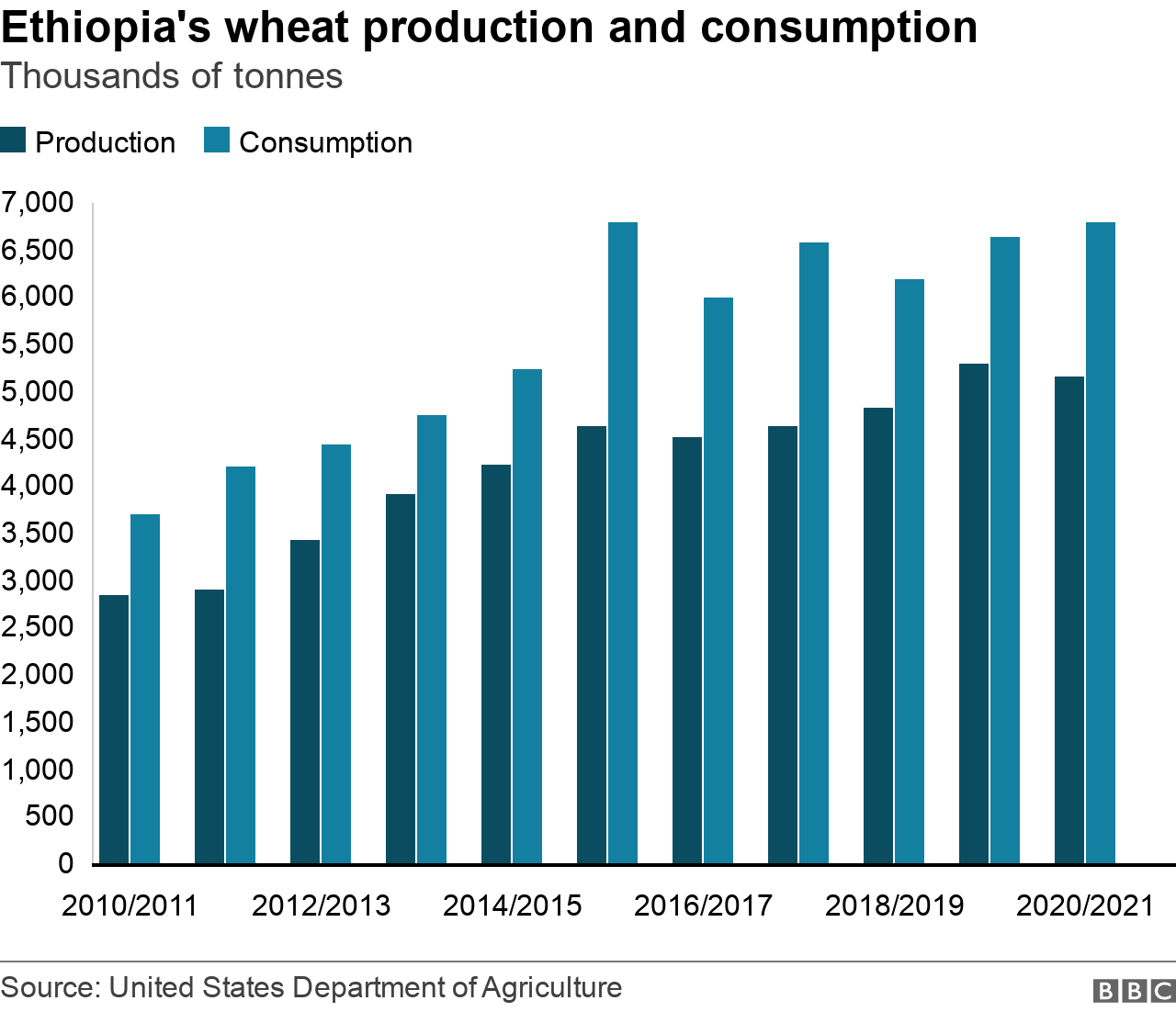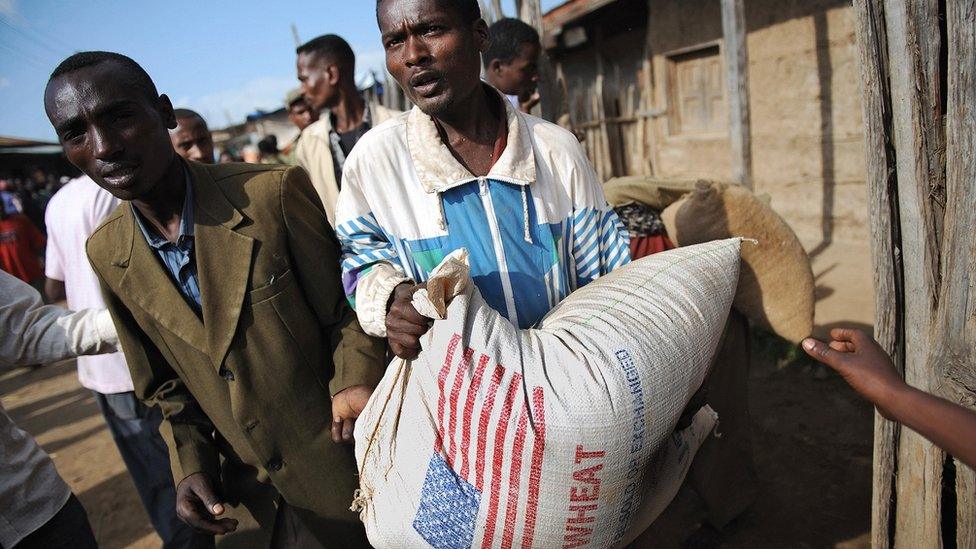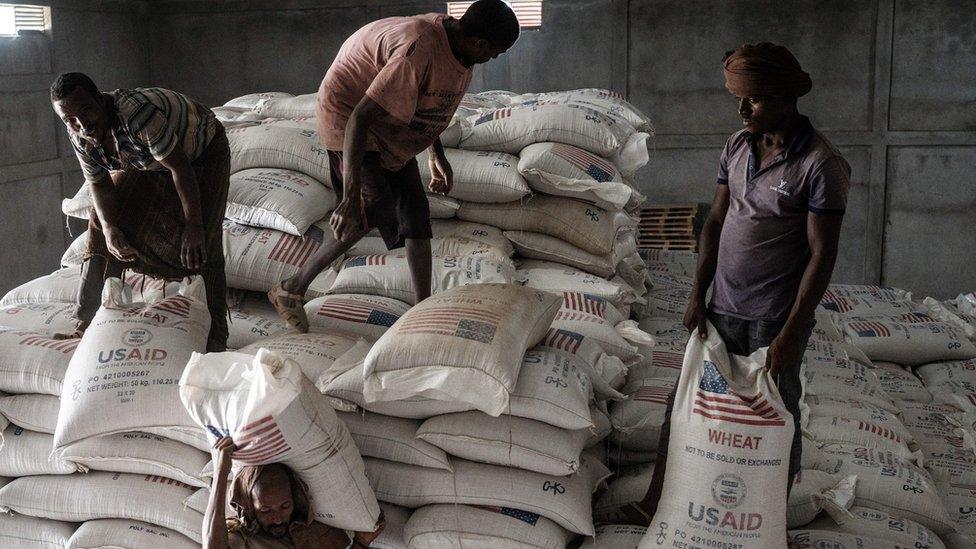Ethiopia food crisis: Why does PM have a problem with wheat aid?
- Published

Ethiopia has been faced by some devastating droughts requiring distribution of food aid
Ethiopia's Prime Minister Abiy Ahmed has claimed that most of the country's problems, including the importing of diseases, stem from foreign wheat aid.
"Ethiopia's problem is wheat aid. With wheat aid comes diseases," said Mr Abiy. "If we stop it, many of the problems will be solved."
So is Mr Abiy right to associate wheat imports with diseases and other challenges facing Ethiopia?
Ethiopia's growing dependence on wheat
Wheat has not traditionally been a staple crop in Ethiopia, but it has been growing in popularity in recent years, especially in urban areas.
It is now the largest producer of wheat in sub-Saharan Africa, but production has consistently fallen short of demand.
The country has also been facing food shortages and droughts, with millions of people requiring food aid.

To meet the shortfall, Ethiopia is currently importing about one-quarter of its wheat, and about a quarter of that arrives as food aid, much of it from the United States.
Can wheat imports bring disease?
Mr Abiy was speaking to farmers in the Oromia region when he referred to diseases being brought in with imported wheat.
One of the most problematic diseases for farmers in Ethiopia has been wheat rust, caused by a fungus carried by the wind.
An outbreak in 2010 affected 30% of cultivated areas and reduced production by more than 15%., external

Most of the wheat from the US arrives in Ethiopia as aid
The most effective method of controlling wheat rust is by breeding resistant wheat cultivars, but new strains of the fungus pose a continuing threat.
In 2013, a new variant of stem rust was able to attack a previously resistant variety of wheat (known as digalu), leading to widespread losses.
A study published in 2017, external shows this particular fungus variant probably originated from Yemen before crossing over, airborne, into Ethiopia. It, however, does not rule out that it may have also come from other Middle East or Eastern African countries.
It's certainly possible that crop diseases and pests can enter a country through aid or imported crops, says Wuletaw Tadesse Degu, an expert in wheat production at the International Center for Agricultural Research in the Dry Areas.
This is particularly likely in countries where the quarantine facilities are weak.
"There have been claims that many of the aggressive weeds and pests prevailing currently in the country were imported," he says.
"Our rivers and lakes, farmlands and range lands are threatened by aggressive weeds which didn't exist before in Ethiopia."

Some wheat diseases can be spread through seed, but others are airborne
Experts have told the BBC that any grain coming to a country needs to be carefully checked to ensure it is free from diseases.
Globally there are instances where disease has spread through imports. One example is wheat blast which is seed-borne, and recently moved from South America to Bangladesh and Zambia through grain trade.
For wheat rust, however, which is windborne as opposed to being carried by seed, it is not always the case that new strains come from outside the region.
There is evidence that some new rust strains have evolved within the East Africa region as much as some have come from elsewhere.
The US international development agency told the BBC: "US food assistance is subject to stringent quality control to meet all international standards." It added the aid complies with local food safety and quality regulations.
What the Ethiopian government says
We asked the Ethiopian government for more details on the diseases to which the prime minister had been referring. His spokeswoman, Billene Seyoum, told us Mr Abiy had been talking more generally about the need to move away from wheat and towards healthier local produce.
"Obesity, diabetes, for example, are associated with high carbs intake. So his overall message is centred on the need to decrease aid dependency by enhancing our own agricultural productivity," she said.
This response, however, doesn't explain why the government only has an issue with imported wheat and not the locally produced crop, which provides three-quarters of the country's overall supply.
Ms Billene also said that a direct result of stopping reliance on wheat imports would be a saving on foreign currency.
Ethiopia subsidises the importation of wheat, providing it to large-scale millers who in turn sell the flour to bakeries at controlled prices.
Stopping imports would mean the government no longer spends money subsidising these wheat purchases.
"Dependency on aid has held back most Ethiopians, and for that matter Africans, from utilising resources effectively," says Ms Seyoum.
"Also foreign exchange being spent on importing wheat will start going into other productive sectors."
Can Ethiopia grow more wheat?
Most of the wheat in Ethiopia is grown by smallholder farmers.
With increased mechanisation, yields have doubled over the last 15 years according to government data.
However, productivity remains low and output still falls short of demand.

Traditionally, Ethiopia has been growing wheat in the highlands and depending on rain.
It is now supplementing that by growing wheat in the lowlands, which are often drier, through irrigation.
The government is also encouraging "cluster farming", mechanisation and subsidising and distributing inputs such as fertiliser and high-quality seed.
Through this, Ethiopia is pushing to fully stop importing wheat by 2023.
"It is a very realistic and achievable goal, since we have irrigable 500,000 hectares of land which is not currently cultivated," says Mr Tadesse.
